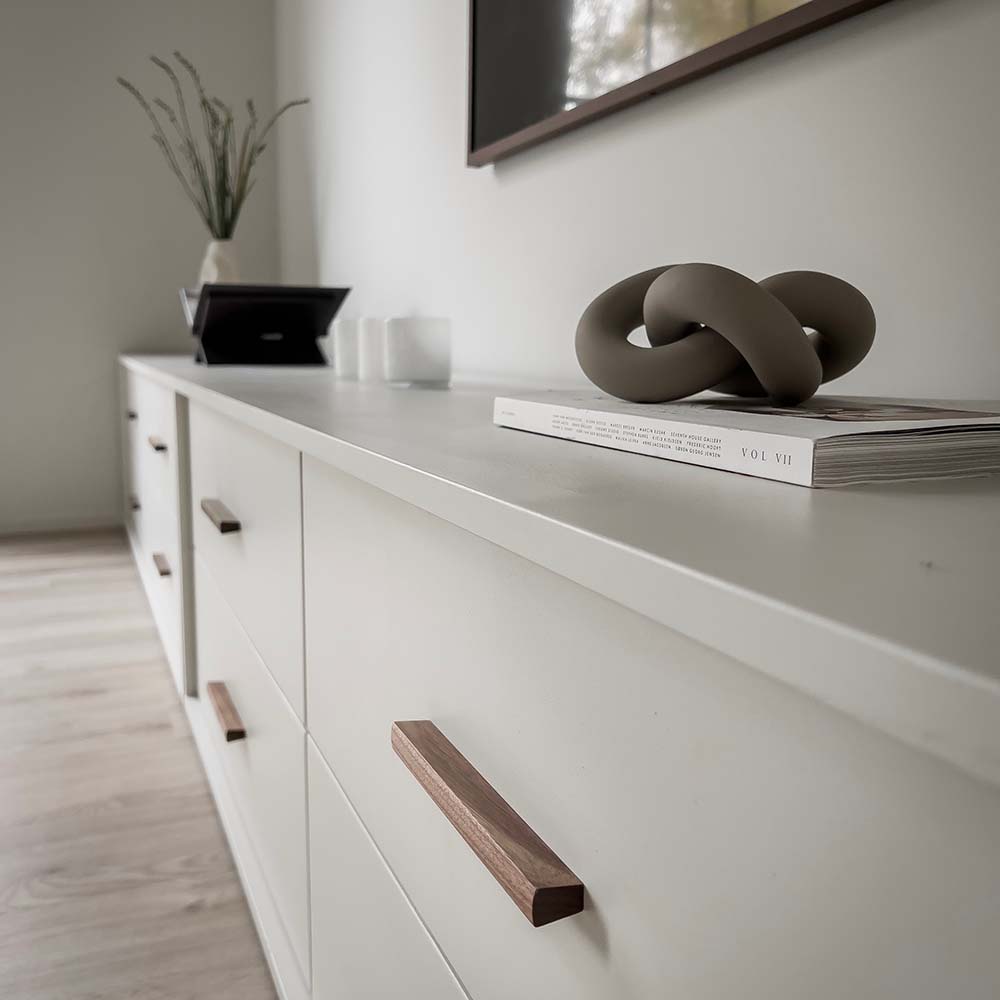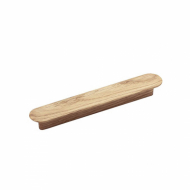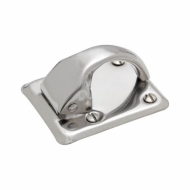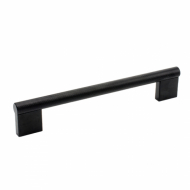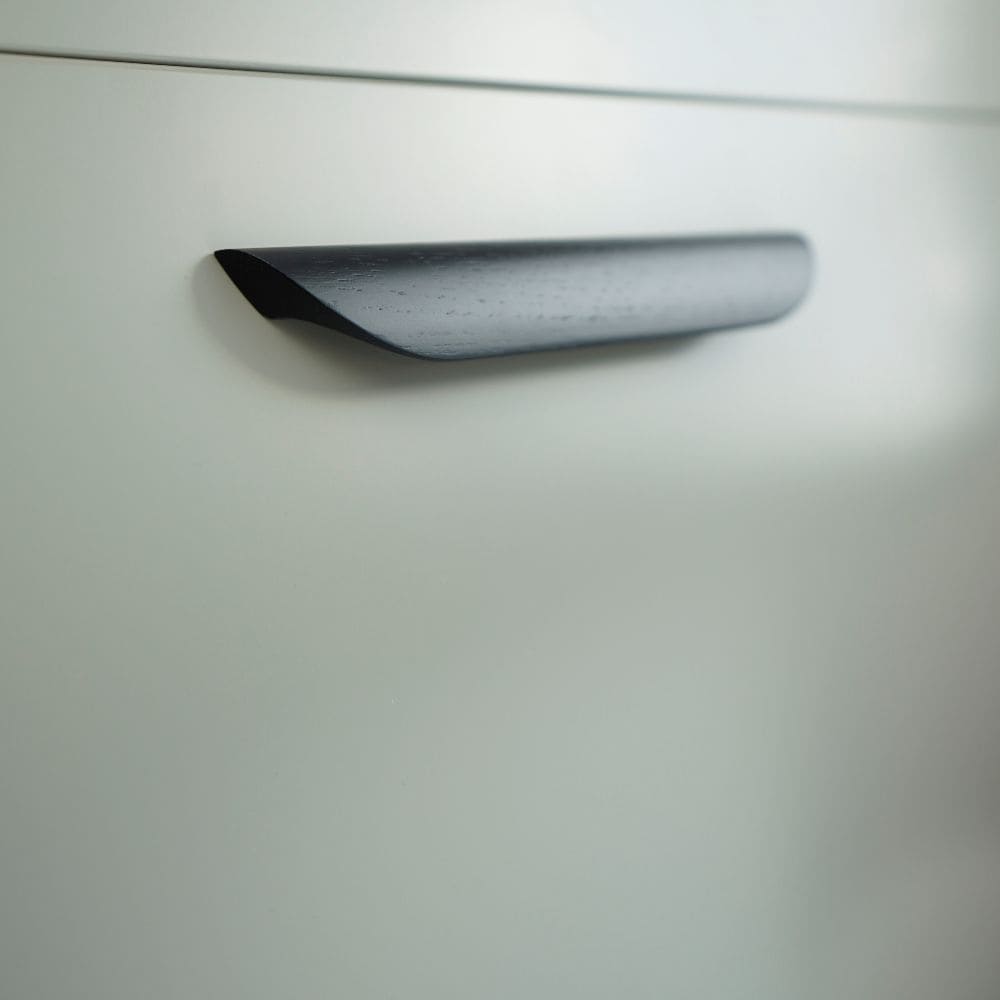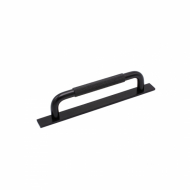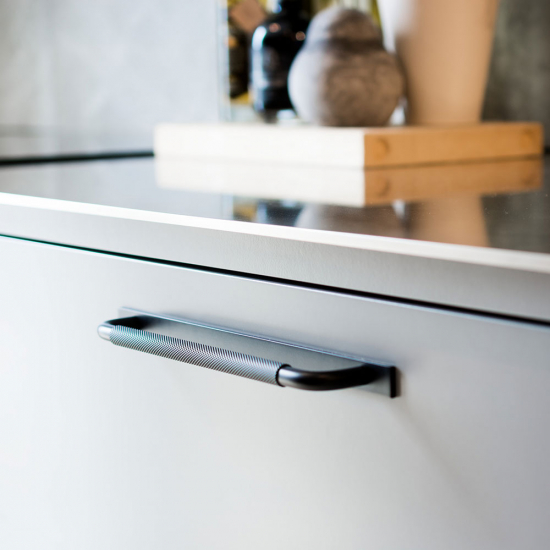
Placement on drawers and doors
When it comes to the placement of handles on drawers, the handles are positioned as shown in the sketch below to indicate that it is a drawer to be pulled out. For base cabinets with doors, the handle is placed vertically on the opposite side from the hinges. This is practical and quickly shows that it is a door to be opened and the direction in which it opens. See the sketch below.

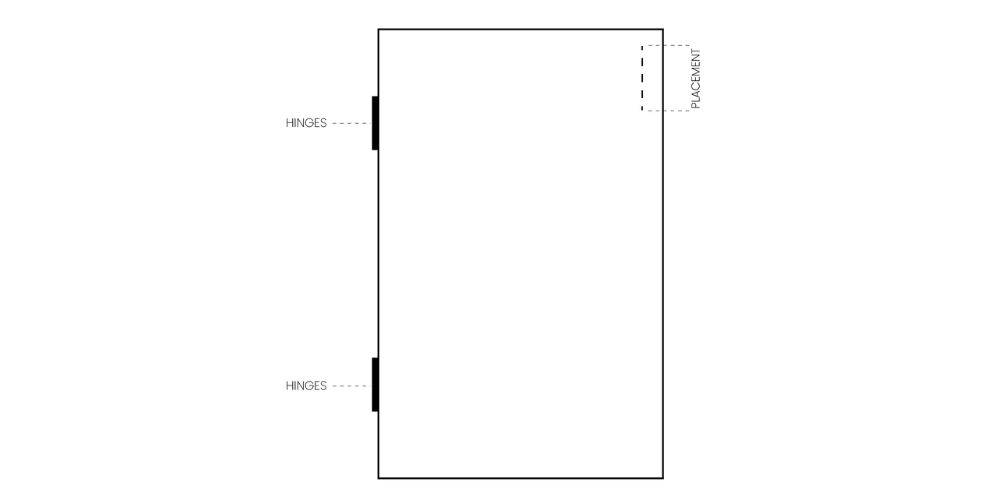
Framed doors and framed drawers
What we recommend is to have the same reference point on all doors and drawers to create a harmonious overall look. A reference point can, for example, be having the same distance from the centre of the handle to the edge of the drawer or door as on the other doors and drawers in your kitchen or bathroom.
To determine the distance from the handle to the edge of the door or drawer, you can easily measure the thickness of the frame and position the handle in the middle. This measurement can then be used as a reference for placing the remaining handles, which will create a beautiful overall effect in your kitchen or bathroom!
In our videos, you can see how to best position the handles to achieve a sleek and consistent result.
Practical Rules of Thumb
On drawers, the handle is usually placed in the centre to provide a symmetrical and easy-to-grip position. On doors, we recommend placing the handle on the opposite side of the hinges to facilitate opening. For doors that open upwards, the handle should be placed centrally near the bottom edge to make opening and closing easier. On upper cabinets, the handle is placed at the bottom edge of the door, while on base cabinets, it is placed at the top edge.
Popular handles

Placement of handles for upper cabinets
It is common for upper cabinets to have hinges placed at the top edge of the door, which means they open upwards. To facilitate opening and closing, we recommend placing the handle as shown in the sketch below. If the upper cabinet instead has hinges on the side of the door, it is best to place the handle on the opposite side to make opening easier and clearly indicate the direction the door opens. In the video, you can see how to position the handle in the best way.

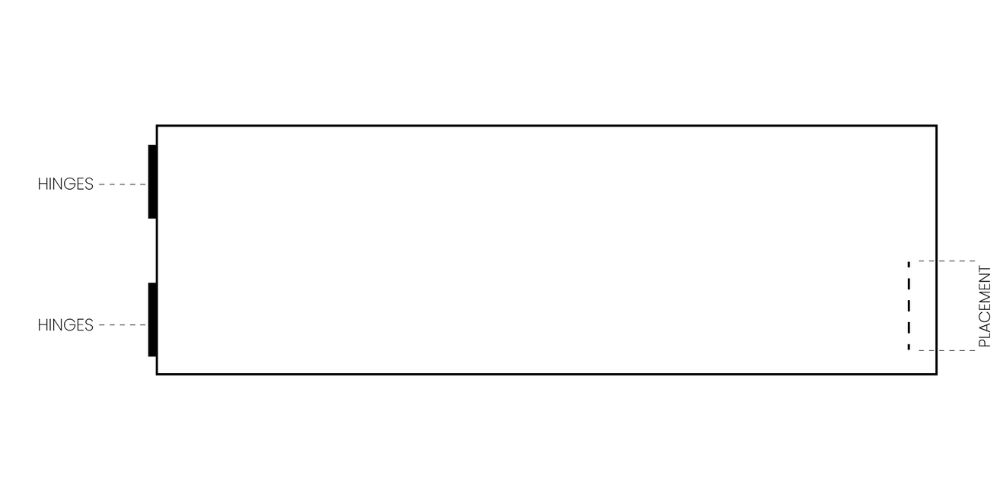
Common Handle Measurements
För att göra det enklare att välja rätt handtag eller knoppar har vi sammanställt de vanligaste måtten som är viktiga att känna till vid köp av handtag. Se bild och beskrivning nedan.
När du väljer handtag finns det fem olika mått att ta hänsyn till, men de viktigaste är:
1. C/C-mått – Avståndet mellan skruvhålen. Detta är särskilt viktigt om du byter ut befintliga handtag och vill undvika nya hål i luckan eller lådan.
2. Handtagets längd – Den totala längden på handtaget, vilket påverkar både estetik och greppvänlighet.
3. Djup (Mått A) – Hur långt ut handtaget sticker från luckan när det är monterat.
4. Bredd/tjocklek på foten (Mått B) – Handtagets bredd vid infästningen, vilket kan påverka stabilitet och design.
5. Totallängd (Mått C) – Handtagets fulla längd från ena änden till den andra.
6. Handtagets tjocklek (Mått D) – Hur kraftigt handtaget känns i handen, vilket påverkar både funktion och stil.
Genom att ha koll på dessa mått blir det enklare att hitta handtag som passar både ditt behov och din befintliga inredning!

Discover our black handles
Placement on flat doors and drawers
An easy way to determine where the handles should sit is to start from the smallest drawer front and place the handle in the centre. This gives you a reference measurement of the distance from handle to edge, which in 9 out of 10 cases works for all drawers and doors.
Want to visualise the placement before drilling? Lay the doors on the floor! This gives you a clear overview of the whole and you can easily test different options before deciding.
Match the handles for a neat overall look:
- Combine handles of different lengths for a dynamic feel.
- Use the same length on all handles for a uniform look.
- Mix handles from the same series for a coherent style.
There is no right or wrong – you decide how your kitchen should look!
General measurement: Handles are usually placed 1.5 – 2.5 cm from the drawer or cabinet edge for a balanced look.
Placement of handles on integrated fridge and freezer
Where should the handle be placed?
- Vertical placement on the side of the door (most common)
- The handle is usually mounted on the side where the door opens, approximately 5–10 cm from the edge, to provide a good grip and avoid bumping into adjacent cabinets.
- On a fridge, the handle is typically placed on the left side if the hinges are on the right, and vice versa.
- On a freezer, the handle is usually aligned with the fridge handle for a uniform look.
- Horizontal placement on the top or bottom edge
- Alternatively, the handle can be mounted horizontally along the top edge of the fridge and the bottom edge of the freezer for a more discreet look.
- This can be practical if you want to mimic the appearance of drawer handles in the kitchen.
Important considerations
- Grip comfort – Ensure the handle has enough space to get a good grip, especially if the fridge or freezer has a strong door closing mechanism.
- Adjustable pressure – Some integrated appliances have a "push-to-open" function, which can affect the need for handles.
- Keep the line! – If you have several handles in the kitchen, try to align the height to create a neat, consistent line across all fittings.
- Avoid handles that are too thin – Fridges and freezers sometimes require extra force to open, so choose a sturdy handle that can handle the load.
By placing the handles correctly, you achieve both a sleek design and smooth operation of your fridge and freezer!
Do you have questions or concerns?
We are here to help you!
Don’t hesitate to contact us if you want tips and advice to find the perfect placement for your handles.
Good luck with your project and your new details – small changes can make a big difference!
Placement on drawers and doors
When it comes to the placement of handles on drawers, the handles are positioned as shown in the sketch below to indicate that it is a drawer to be pulled out.
For base cabinets with doors, the handle is placed vertically on the opposite side from the hinges.
This is practical and quickly makes it clear that it is a door to be opened and shows the direction. See the sketch below.


Placement on framed doors and framed drawers
Use the frame on the doors and drawers as a reference point for placing handles and knobs.
There are different ways to use the frames. Some choose to align the handles with the bottom edge of the frame, while others prefer to place the handles on the right or left edge of the frame.
What we recommend is to have the same reference point on all doors and drawers to create a harmonious overall look. A reference point can, for example, be having the same distance from the centre of the handle to the edge of the drawer or door as on the other doors and drawers in the kitchen or bathroom.
To determine the distance from the handle to the edge of the door or drawer, you can easily measure the thickness of the frame and position the handle in the middle. This measurement is then used as a reference for placing the remaining handles, which will create a beautiful unity in your kitchen or bathroom!
Want to see exactly how you can place the handles and knobs for the best result? Check out our videos where we show different options and how to achieve a sleek and functional placement!
Practical Rules of Thumb
On drawers, the handle is usually placed in the centre to provide a symmetrical and easy-to-grip position.
On doors, we recommend placing the handle on the opposite side of the hinges to facilitate opening.
For doors that open upwards, the handle should be placed centrally near the bottom edge to make opening and closing easier.
On upper cabinets, the handle is placed at the bottom edge of the door, while on base cabinets, it is placed at the top edge.

Popular handles
Placement of handles for upper cabinets
It is common for upper cabinets to have hinges placed at the top edge of the door, which means they open upwards.
To facilitate opening and closing, we recommend placing the handle as shown in the sketch below.
If the upper cabinet instead has hinges on the side of the door, it is best to place the handle on the opposite side to simplify opening and clearly indicate the door’s direction.


Common handle measurements
To make it easier to choose the right handles or knobs, we have compiled the most common measurements that are important to know when buying handles. See the image and description below.
When selecting handles, there are five different measurements to consider, but the most important are:
1. C/C measurement – The distance between the screw holes. This is especially important if you are replacing existing handles and want to avoid new holes in the door or drawer.
2. Handle length – The total length of the handle, which affects both aesthetics and grip comfort.
3. Depth (Measurement A) – How far the handle protrudes from the door when mounted.
4. Width/thickness of the base (Measurement B) – The width of the handle at the mounting point, which can affect stability and design.
5. Total length (Measurement C) – The full length of the handle from one end to the other.
6. Handle thickness (Measurement D) – How sturdy the handle feels in the hand, impacting both function and style.
By keeping track of these measurements, it becomes easier to find handles that suit both your needs and your existing interior!

Discover our black handles
Placement on flat doors and drawers
Determining the placement of handles without guidelines from doors and drawers can feel tricky – but then you simply create your own!
An easy way to decide where the handles should go is to start from the smallest drawer front and place the handle in the centre. This gives you a reference measurement for the distance from the handle to the edge, which works in 9 out of 10 cases for all drawers and doors.
Want to visualise the placement before drilling? Lay the doors out on the floor! This gives you a clear overview of the whole and allows you to easily test different options before making a decision.
Match the handles for a cohesive look:
- Combine handles of different lengths for a dynamic feel.
- Use the same length on all handles for a uniform look.
- Mix handles from the same series for a thoughtful style.
There is no right or wrong – you decide how your kitchen should look!
General measurement: Handles are usually placed 1.5 – 2.5 cm from the drawer or cabinet edge for a balanced look.
Want to see exactly how to place the handles for the best result? Check out our videos where we show different options and how to achieve a sleek and functional placement!
Placement of handles on integrated fridge and freezer
Where should the handle be placed?
- Vertical placement on the side of the door (most common)
- The handle is usually mounted on the side where the door opens, about 5–10 cm from the edge, to provide a good grip and avoid bumping into adjacent cabinets.
- On a fridge, the handle is typically placed on the left side if the hinges are on the right, and vice versa.
- On a freezer, the handle is usually aligned with the fridge handle for a uniform look.
- Horizontal placement on the top or bottom edge
- Alternatively, the handle can be mounted horizontally along the top edge of the fridge and the bottom edge of the freezer for a more discreet look.
- This can be practical if you want to mimic the appearance of drawer handles in the kitchen.
Important considerations
- Grip comfort – Ensure the handle has enough space to get a good grip, especially if the fridge or freezer has a strong door closing mechanism.
- Adjustable pressure – Some integrated appliances have a "push-to-open" function, which can affect the need for handles.
- Keep the line! – If you have multiple handles in the kitchen, try to align the height to create a neat, consistent line across all fittings.
- Avoid handles that are too thin – Fridges and freezers sometimes require extra force to open, so choose a sturdy handle that can withstand the load.
By placing the handles correctly, you achieve both a sleek design and smooth operation of your fridge and freezer!
Do you have questions or concerns?
We are here to help you!
Don’t hesitate to contact us if you want tips and advice to find the perfect placement for your handles.
Good luck with your project and your new details – small changes can make a big difference!


 Retro
Retro  Country
Country Modern
Modern

























